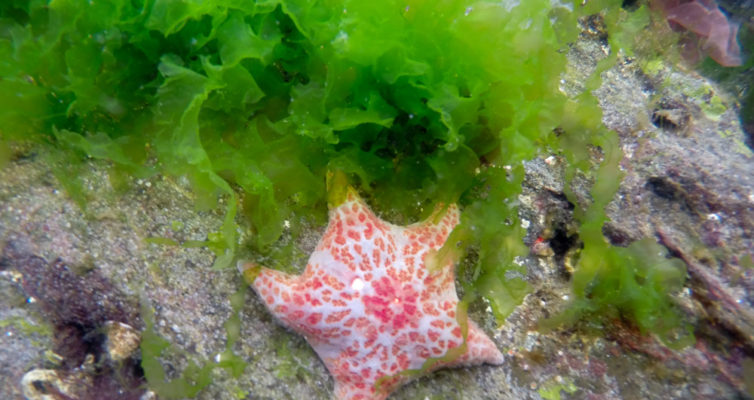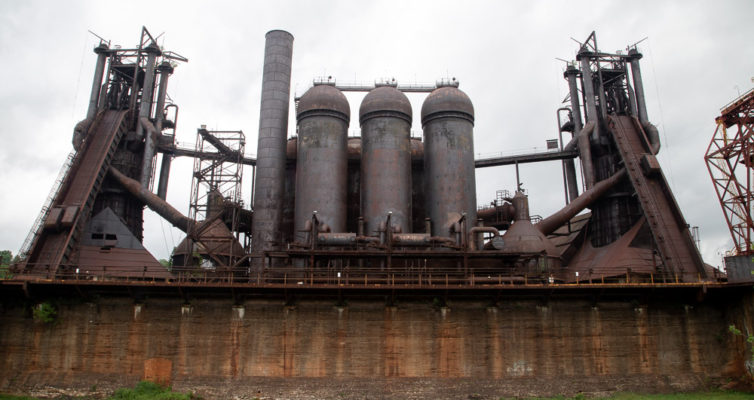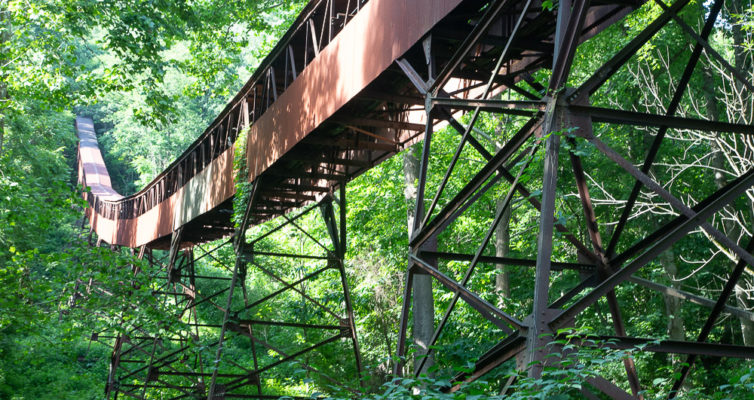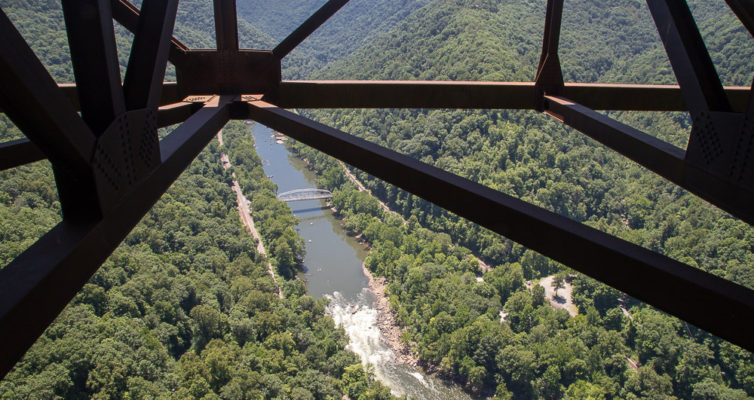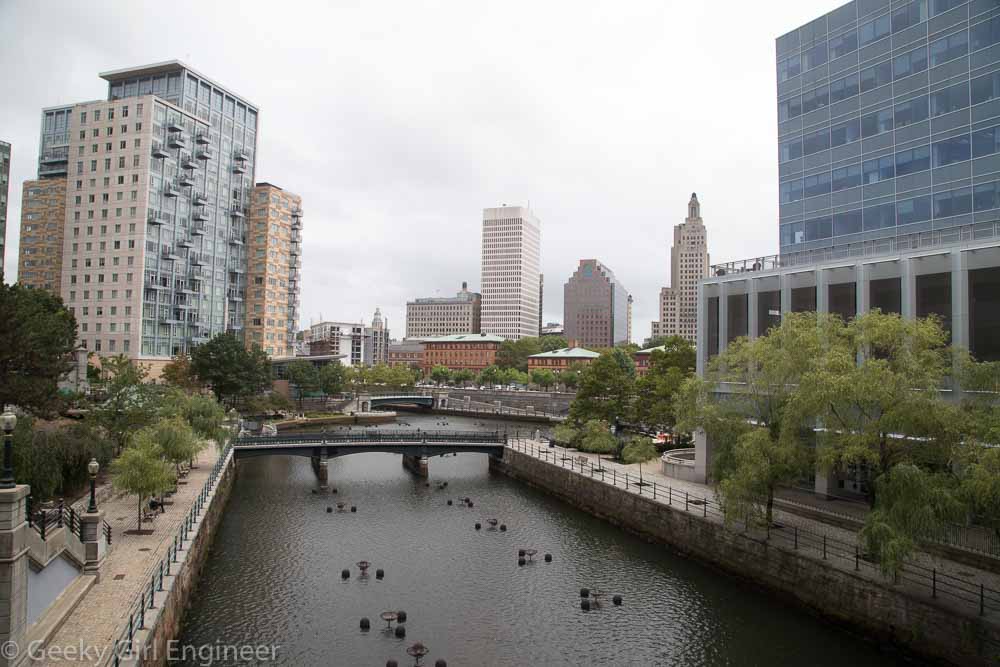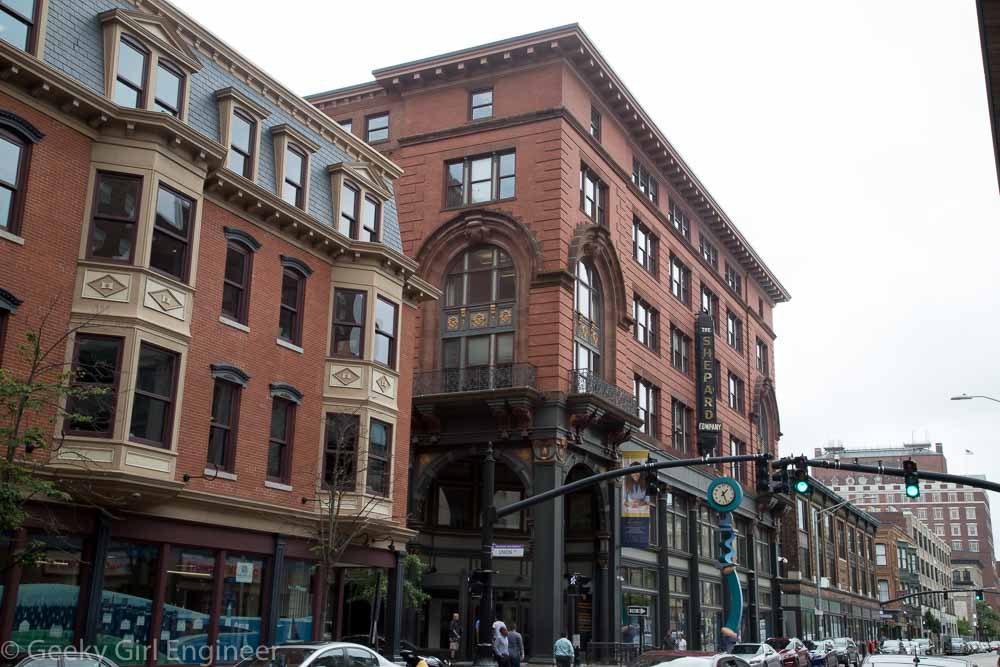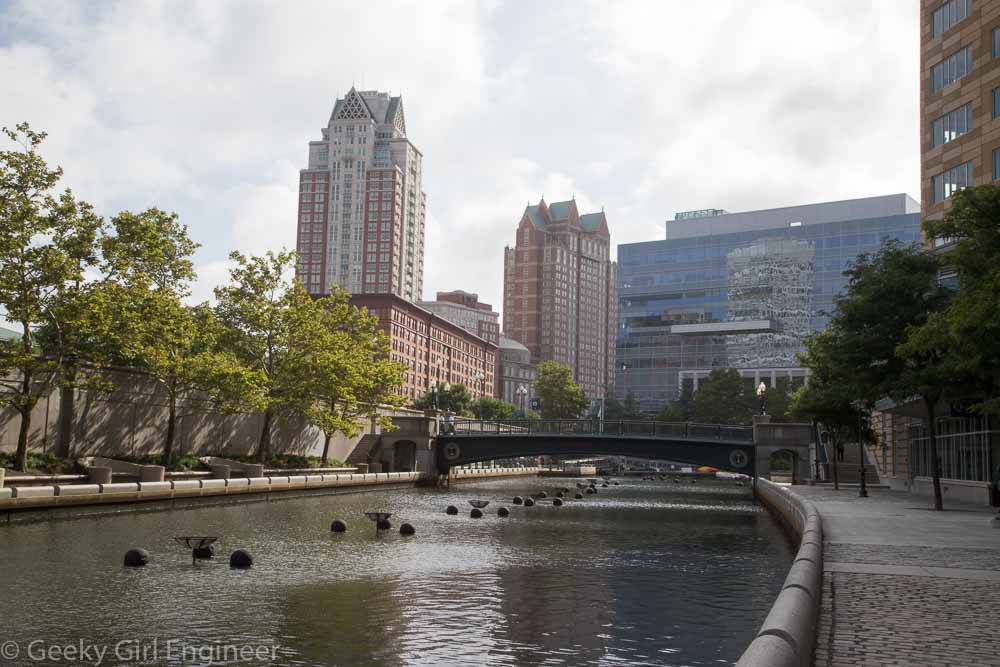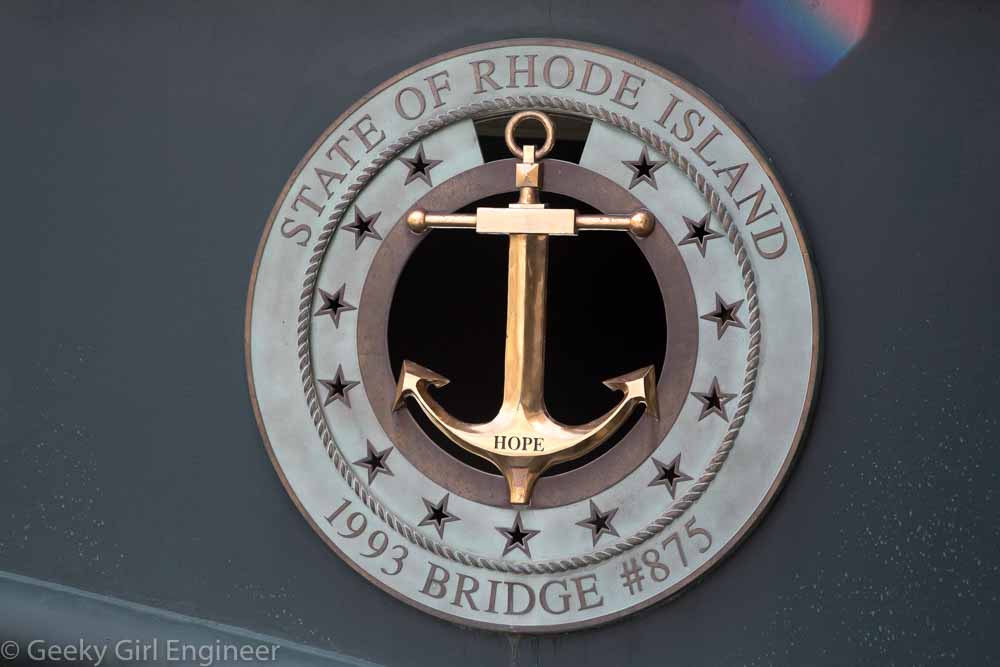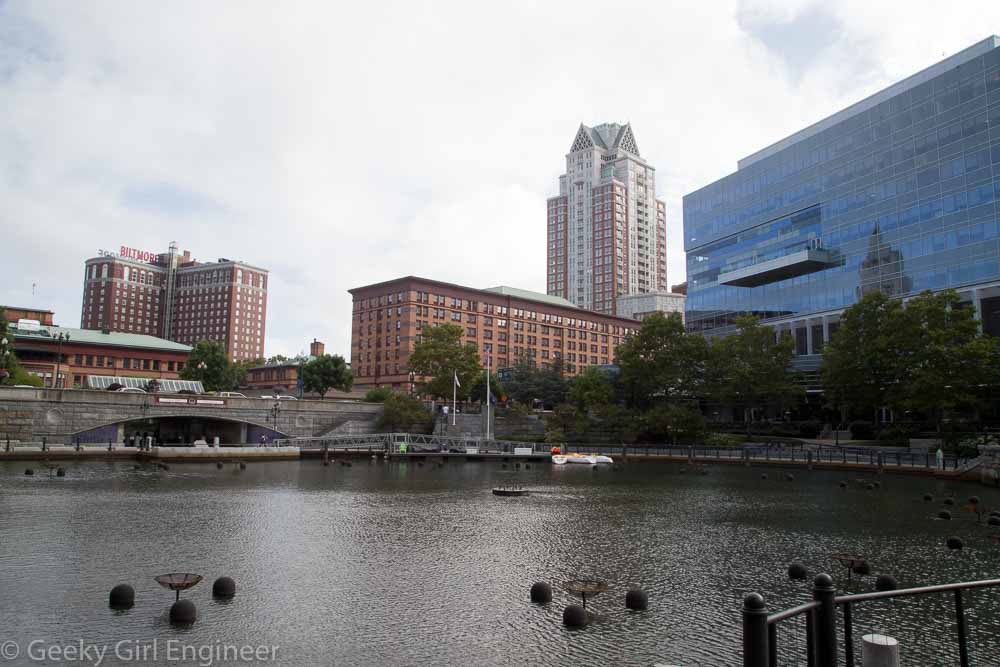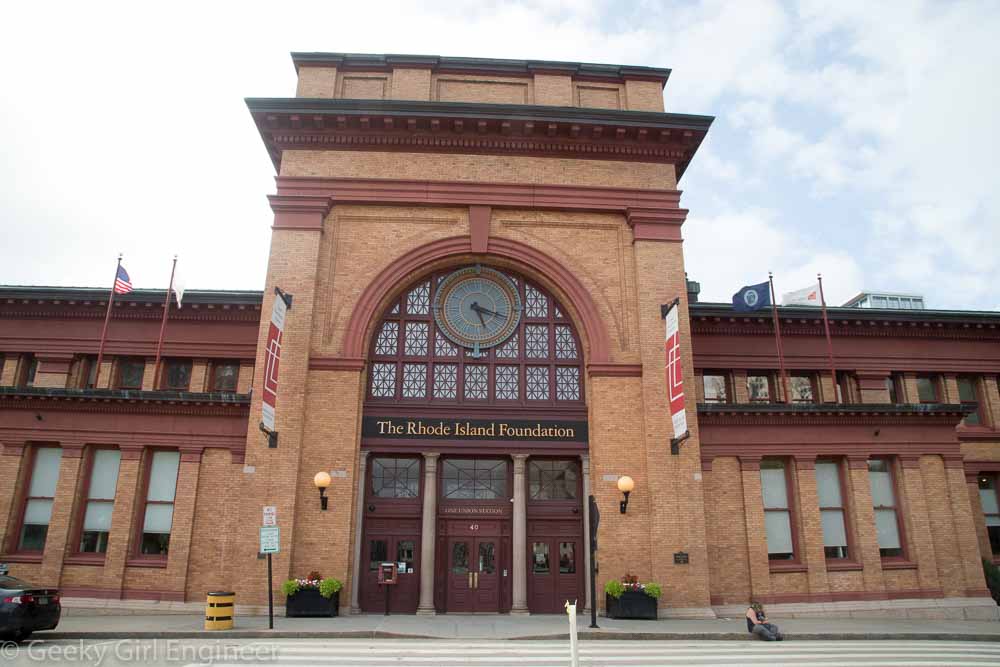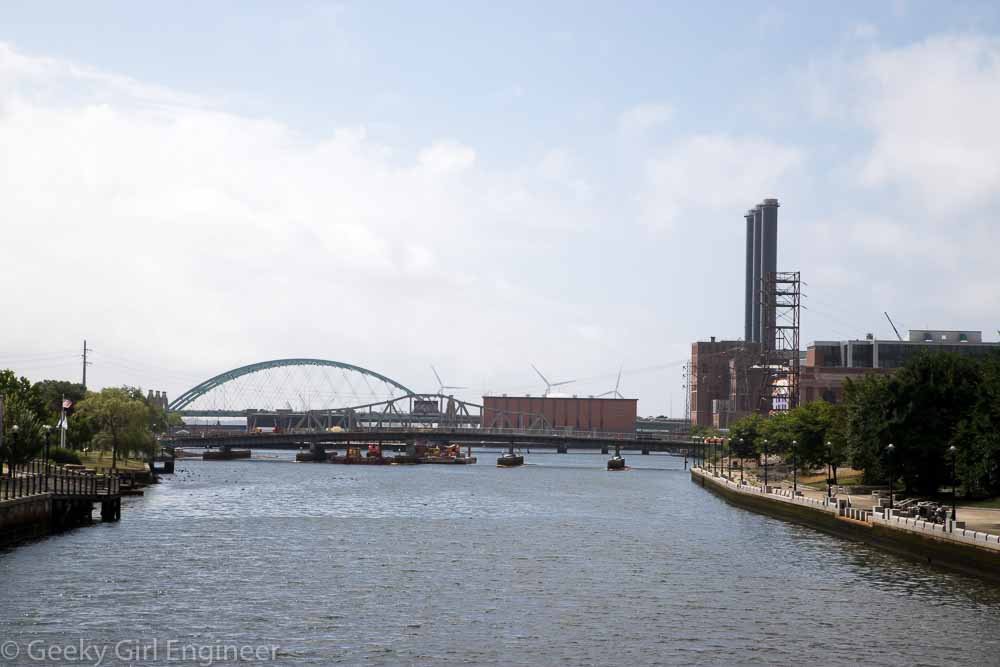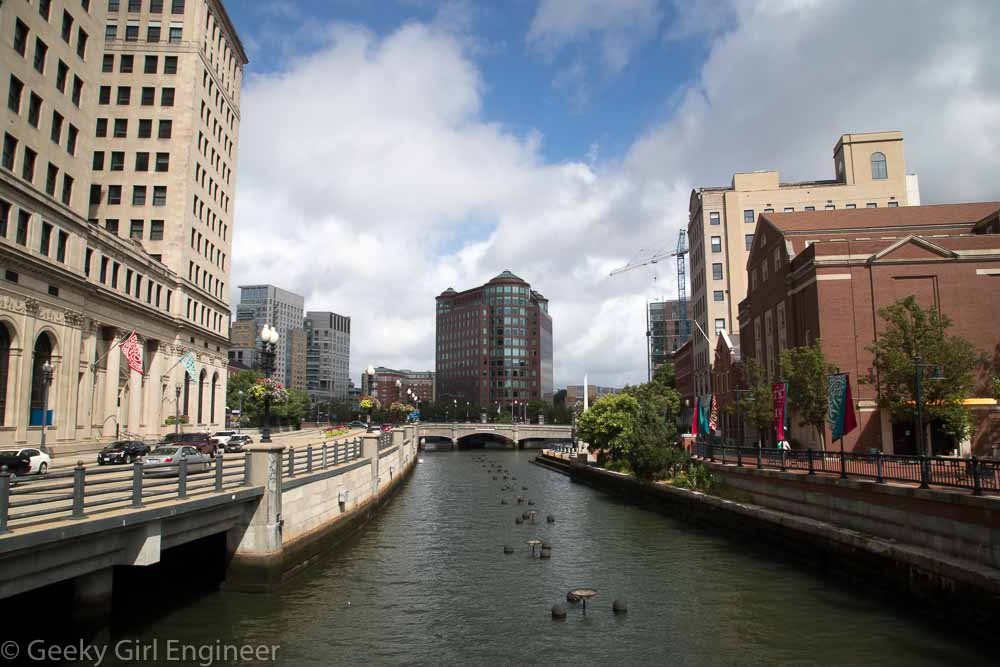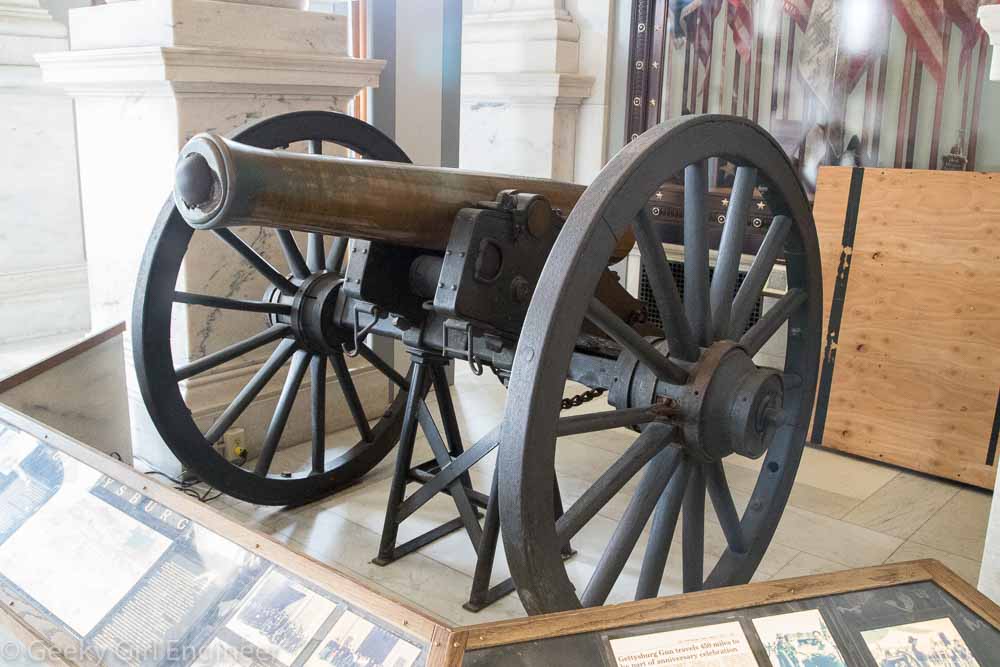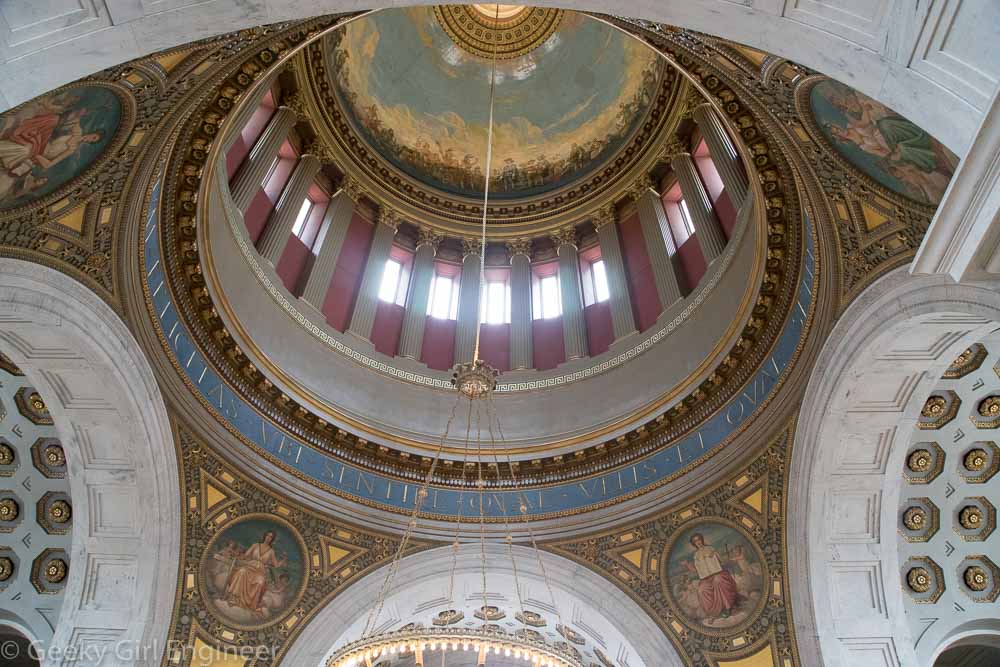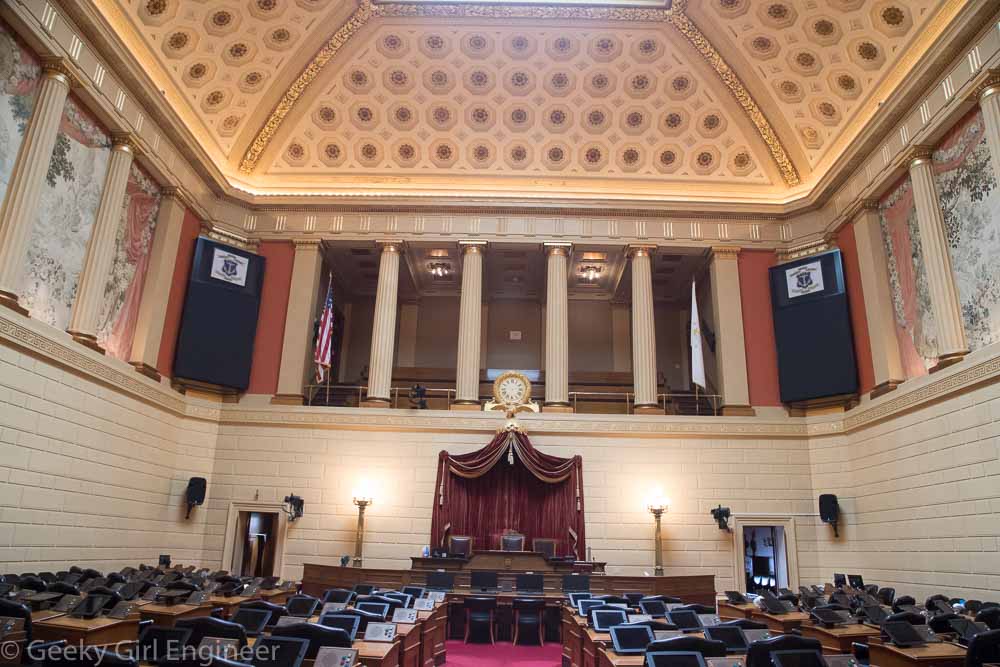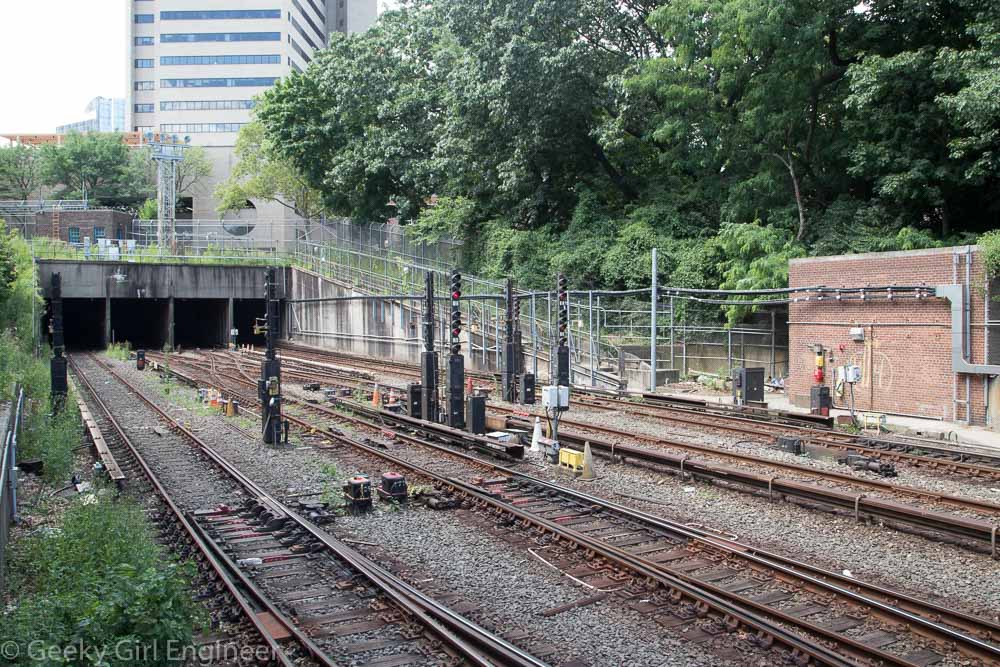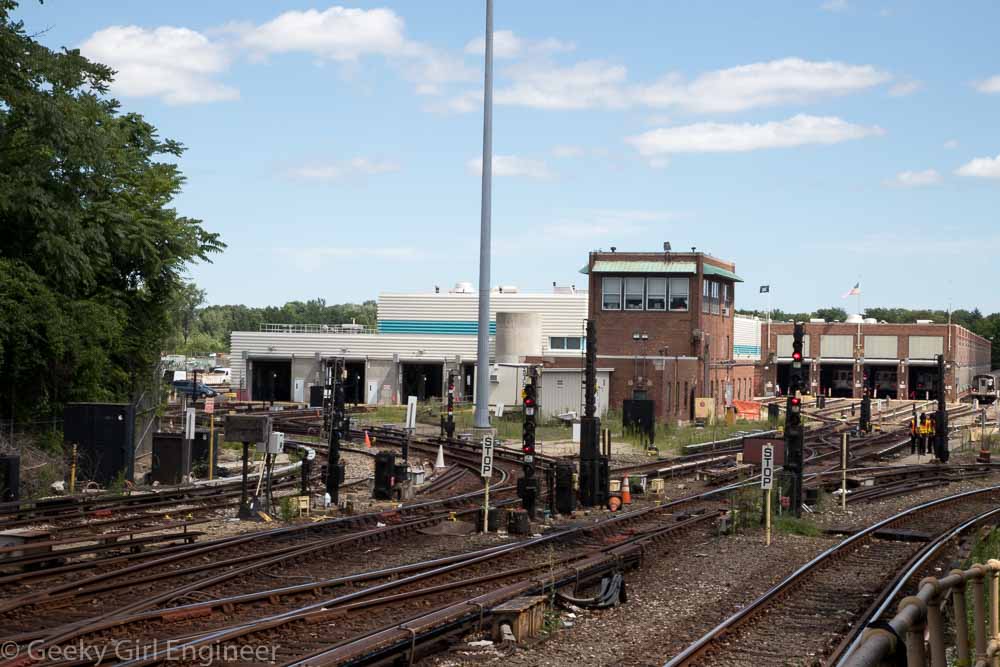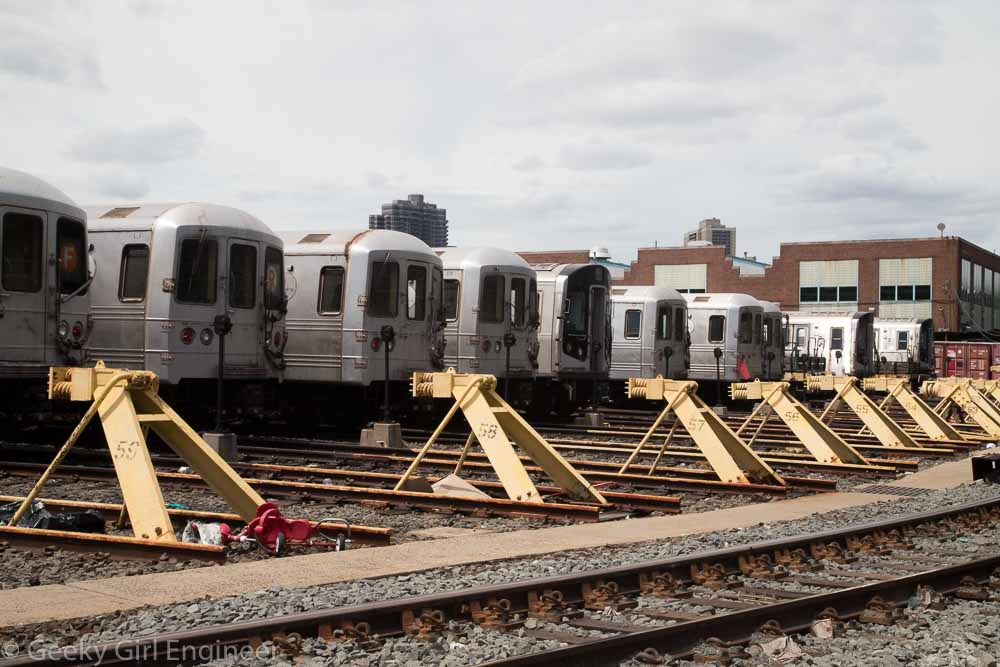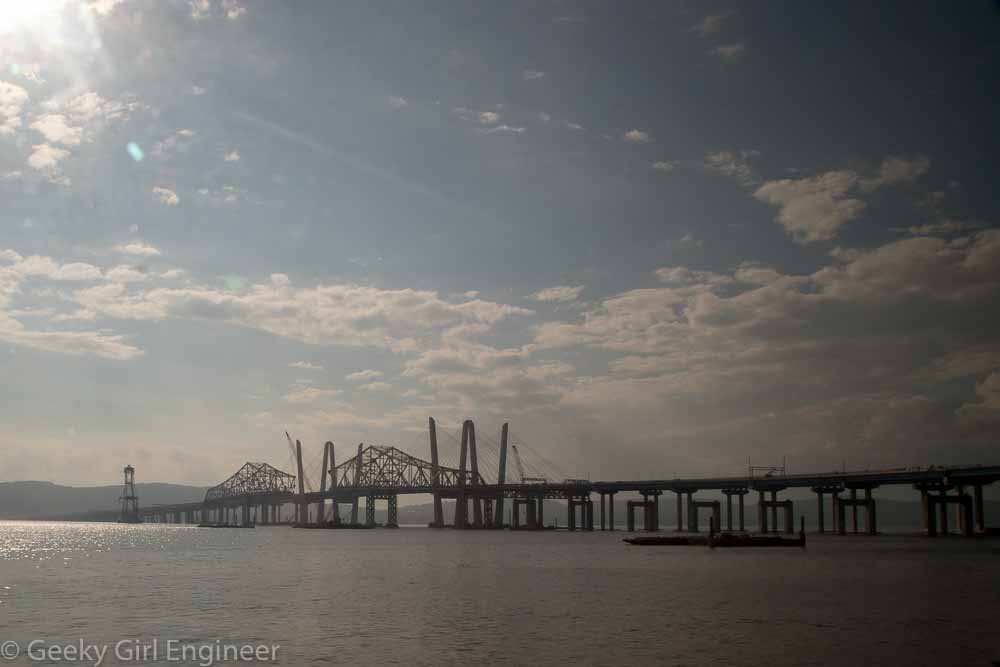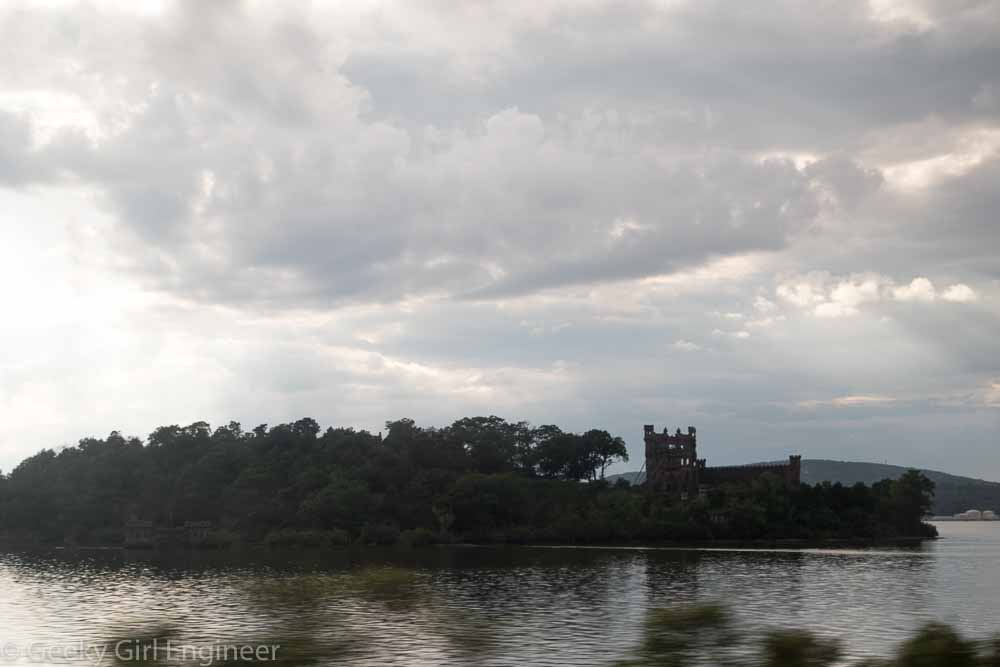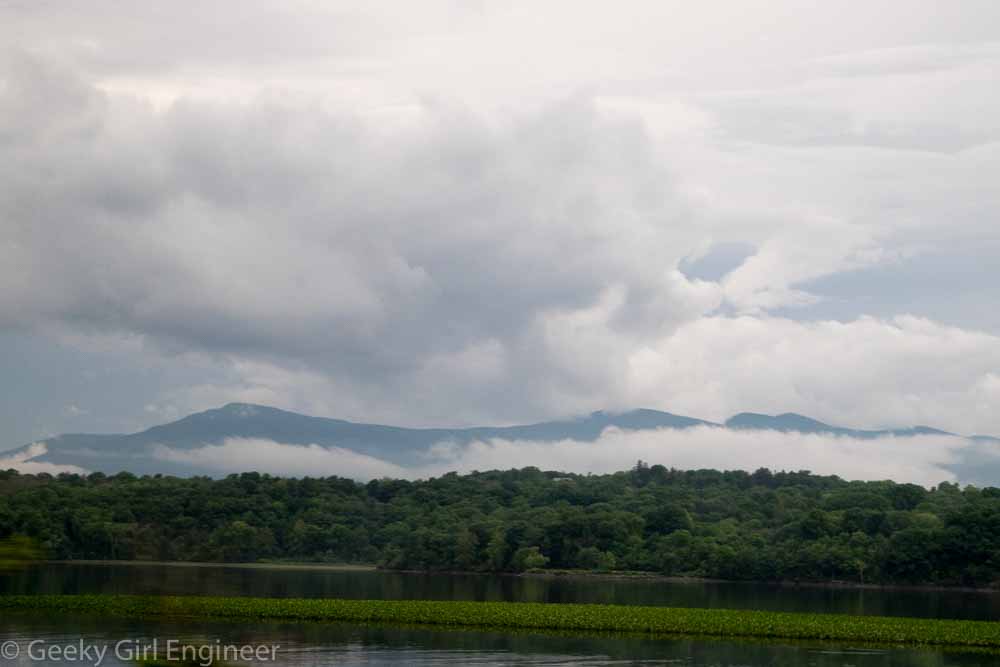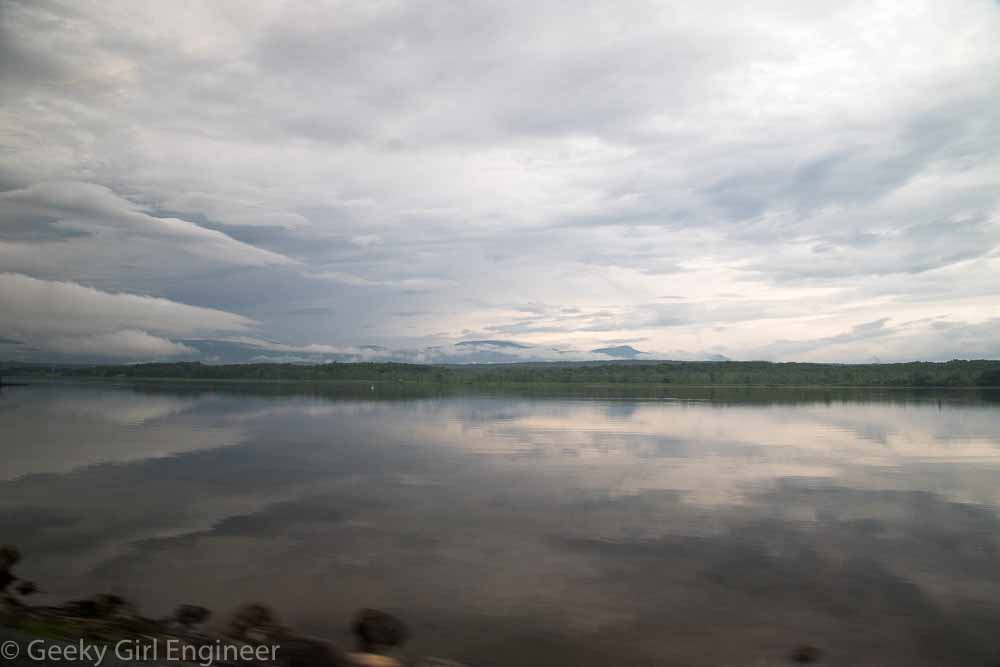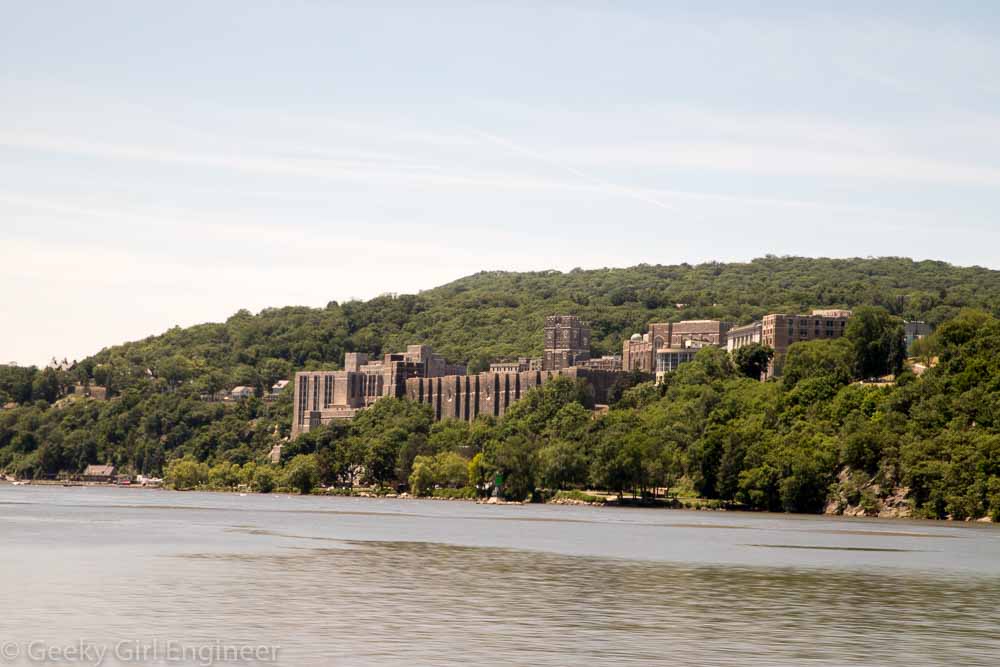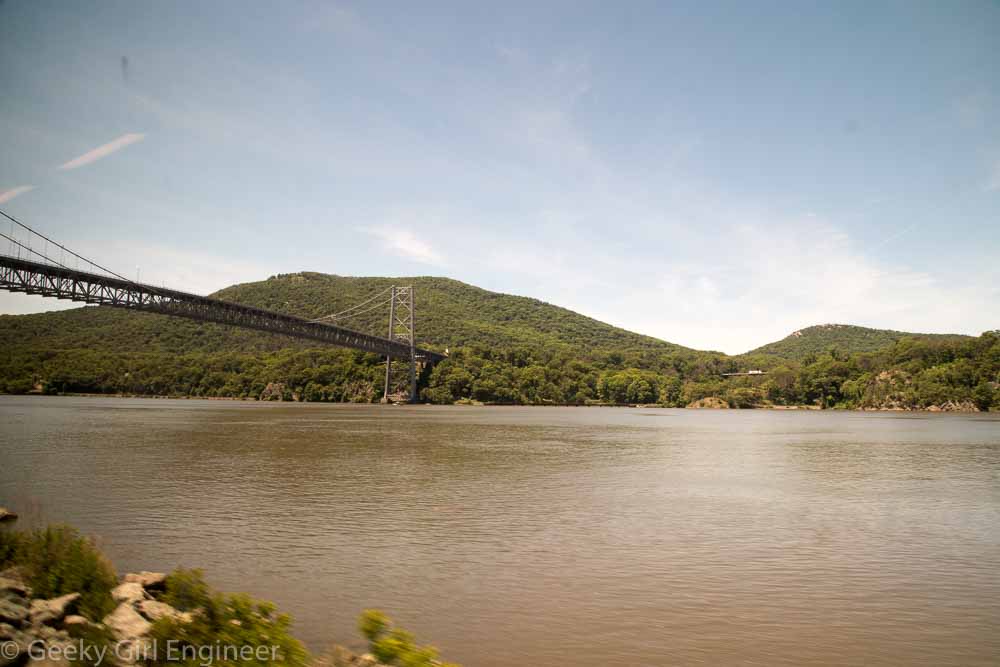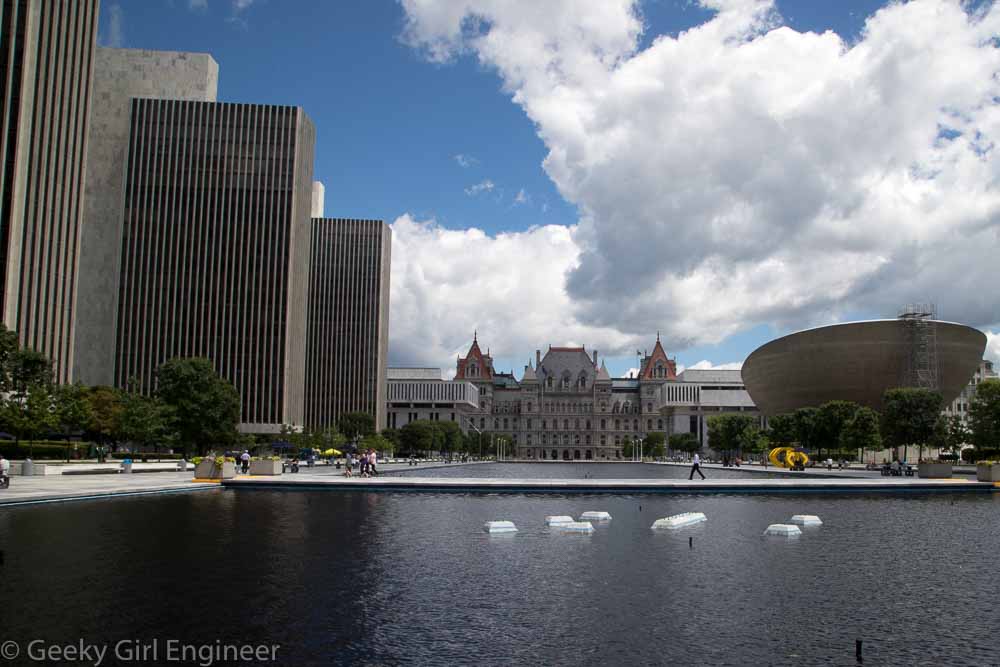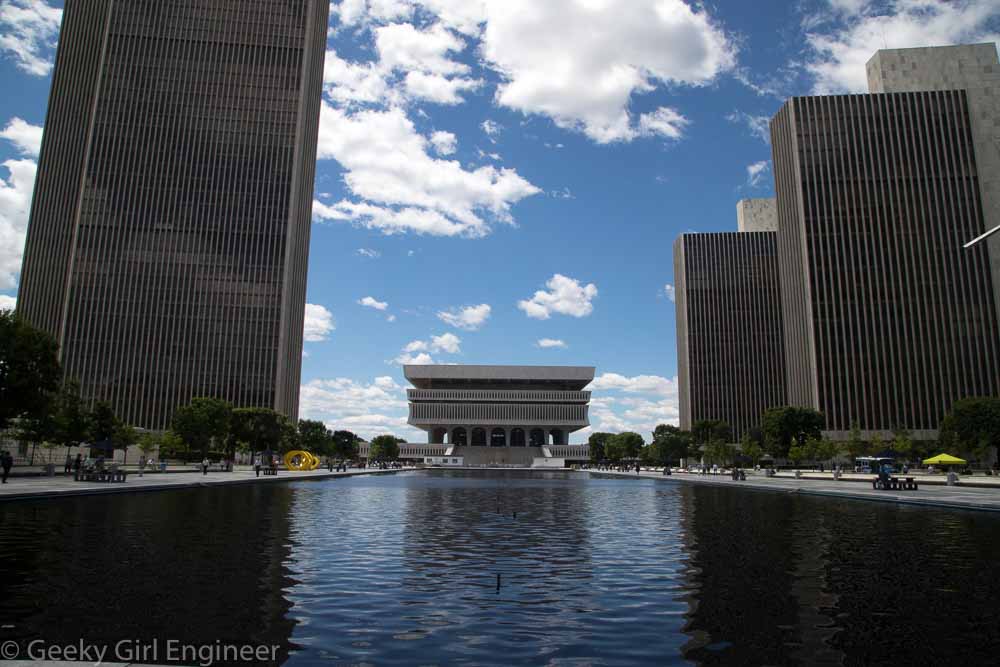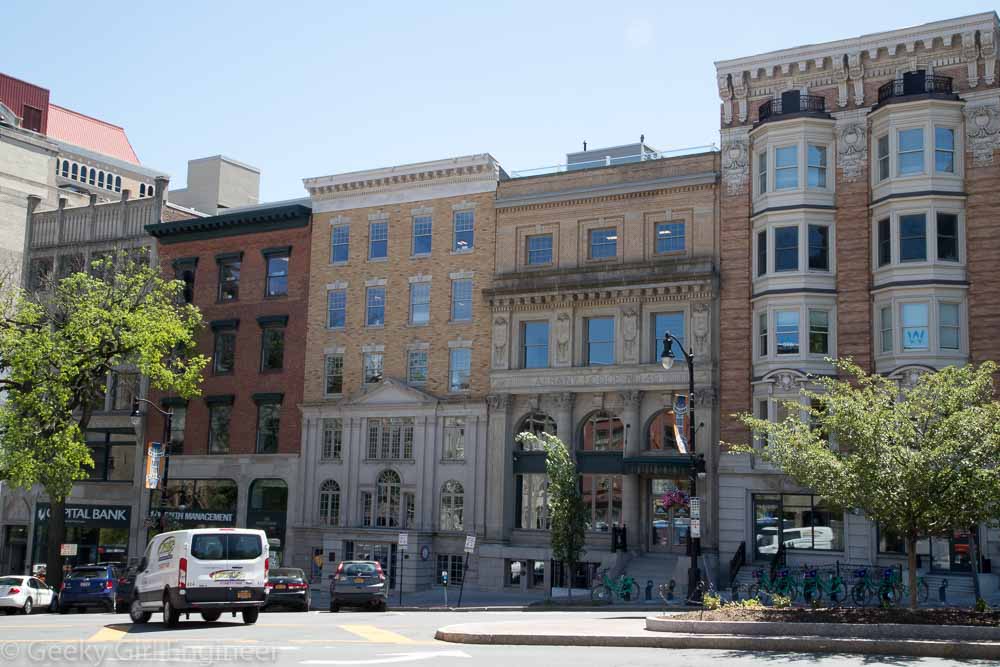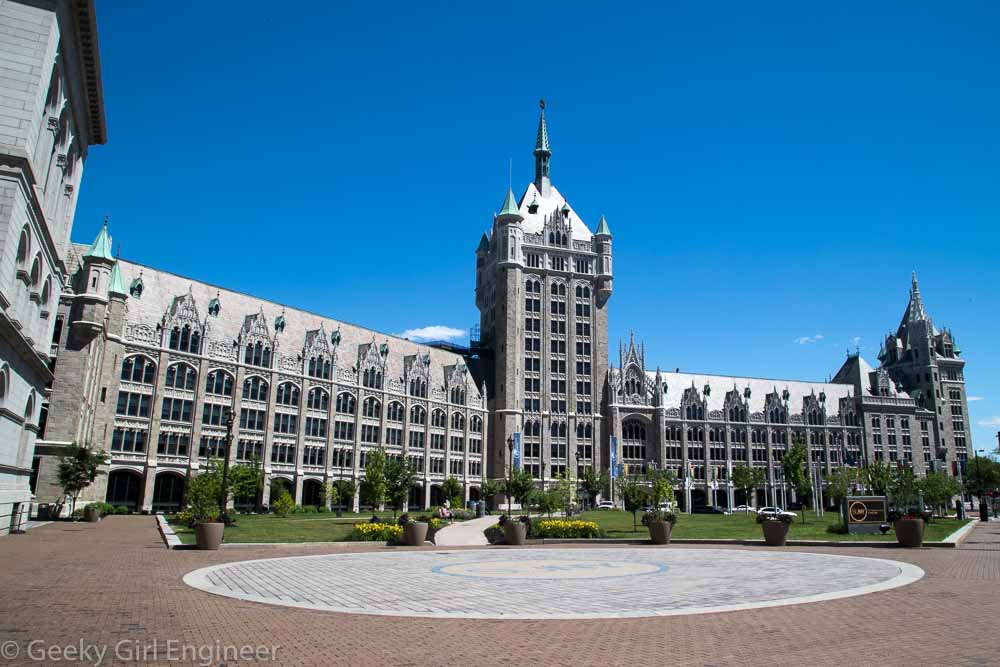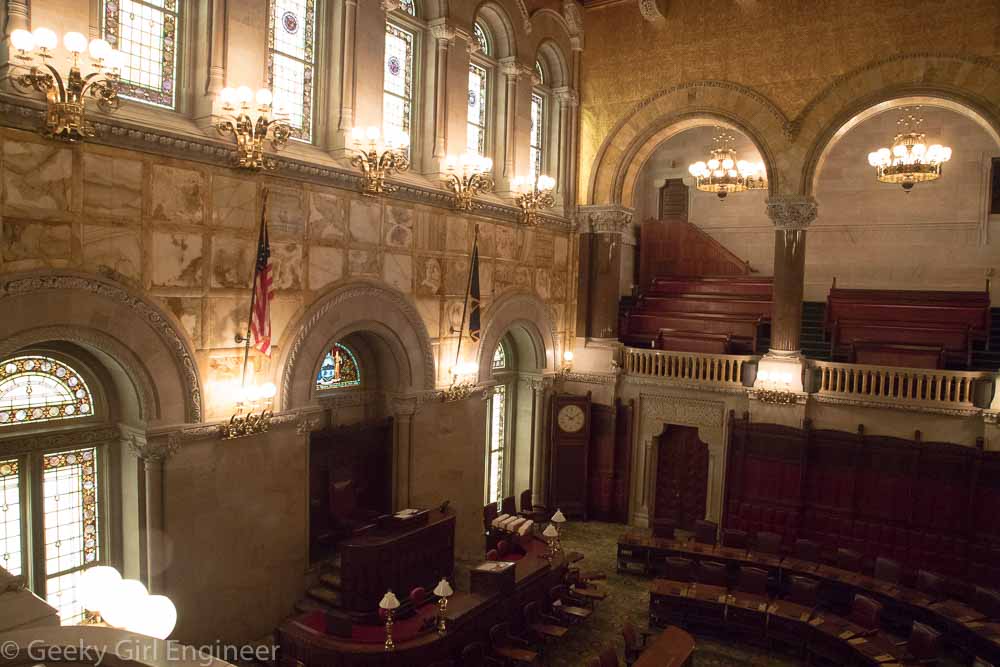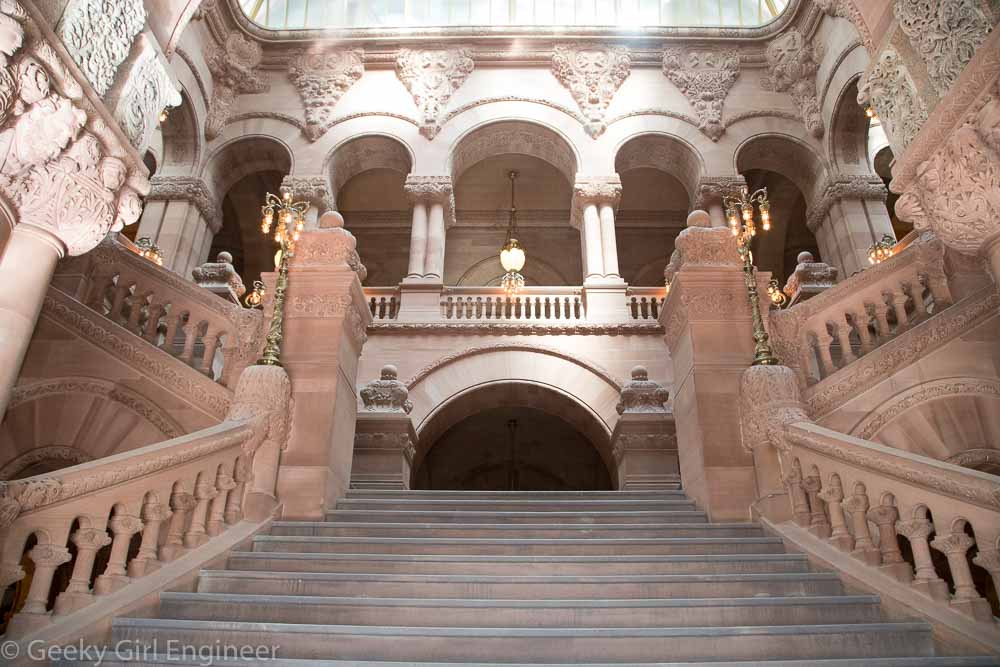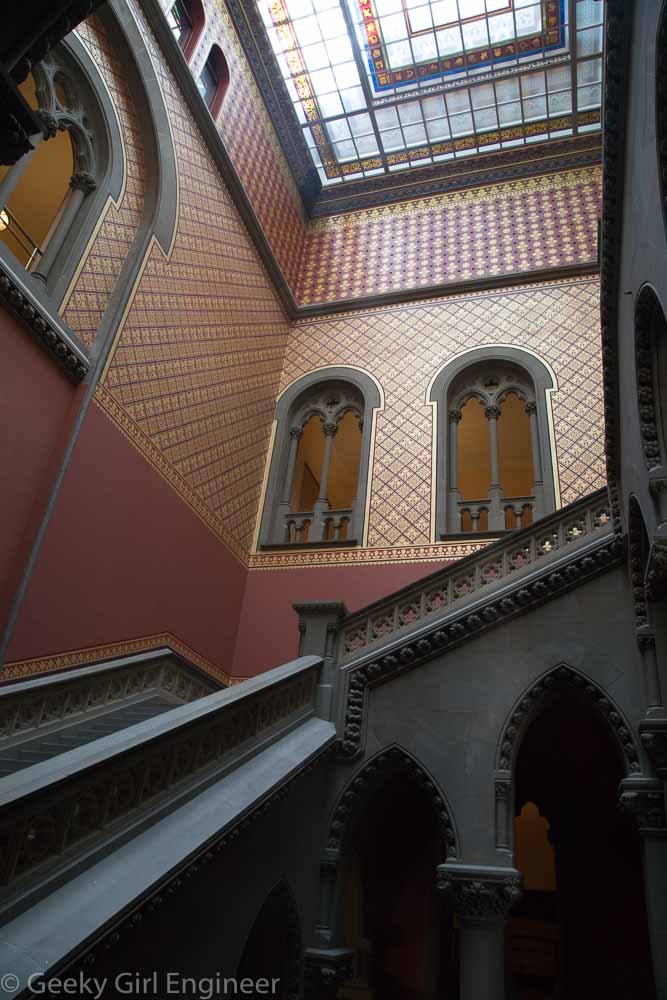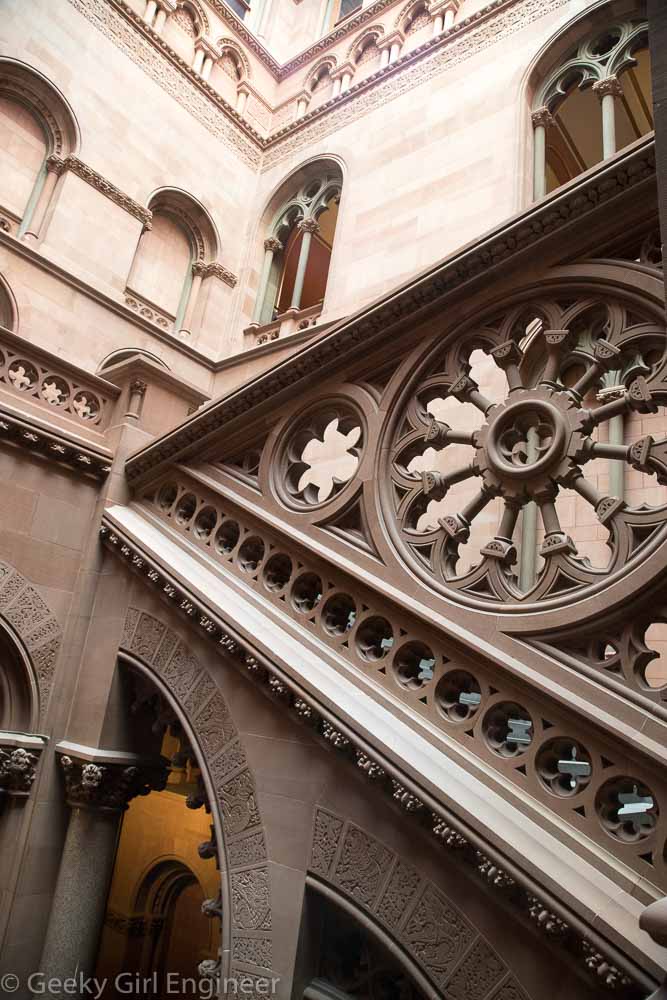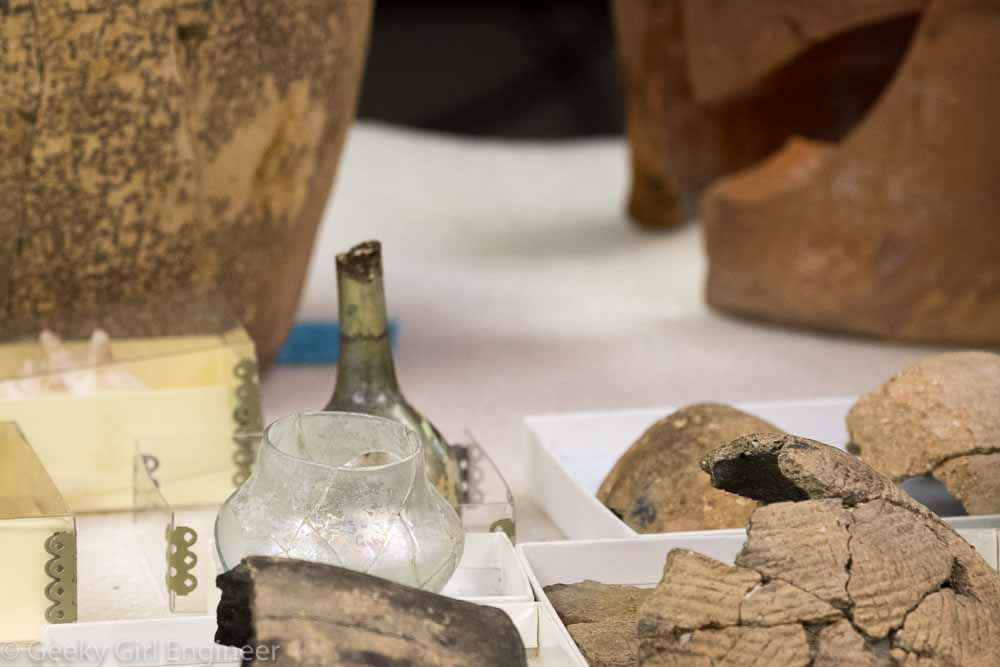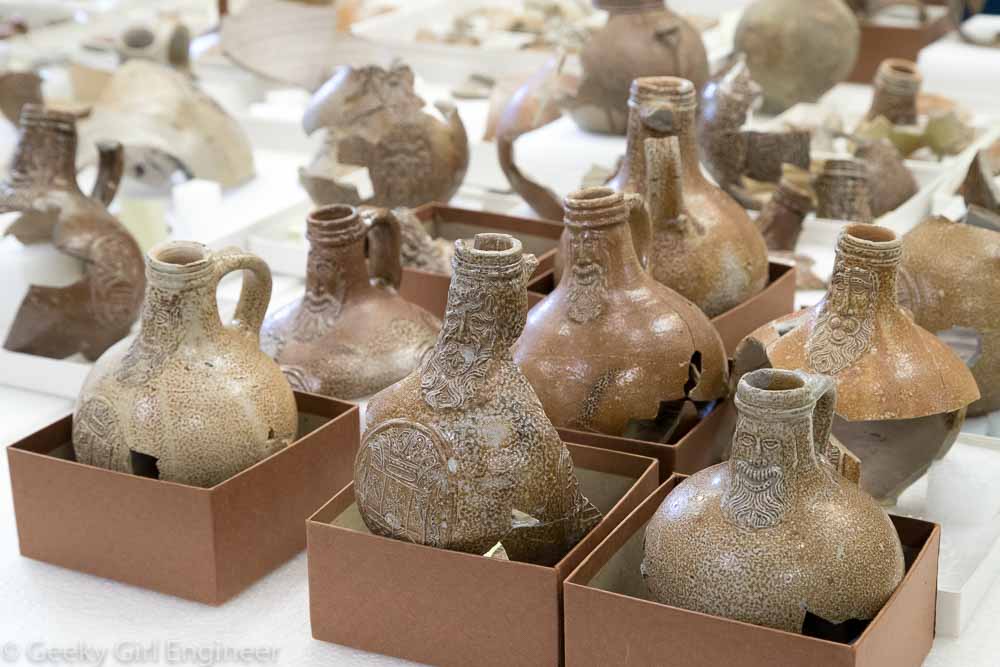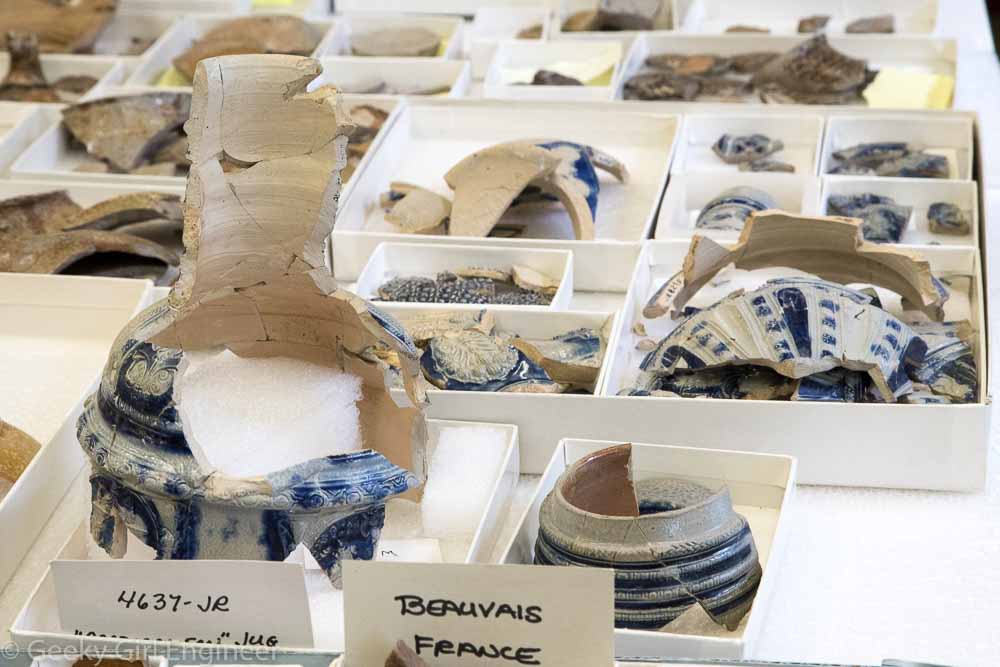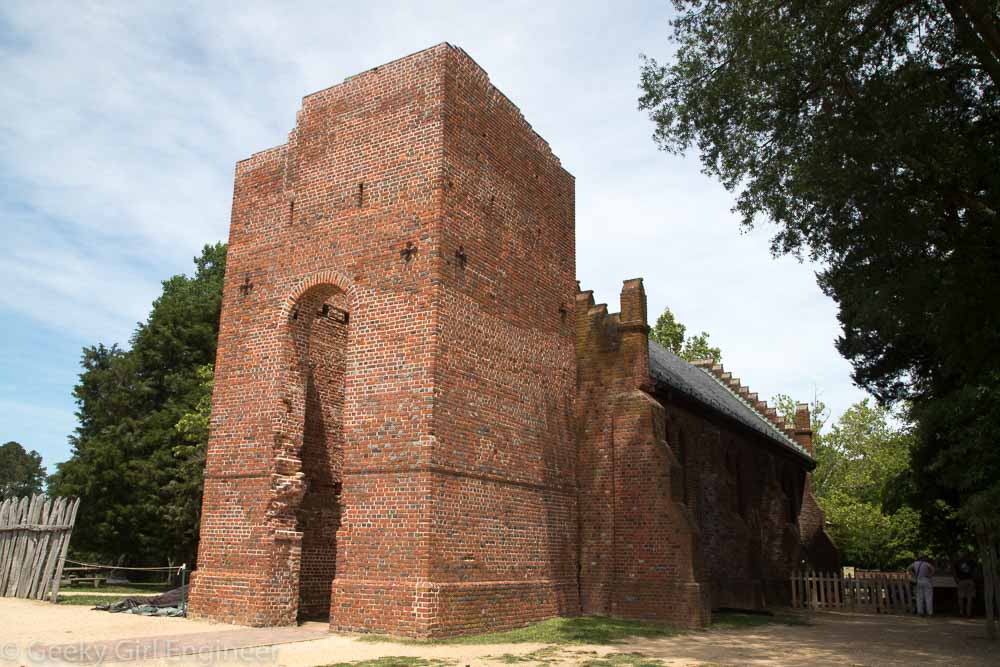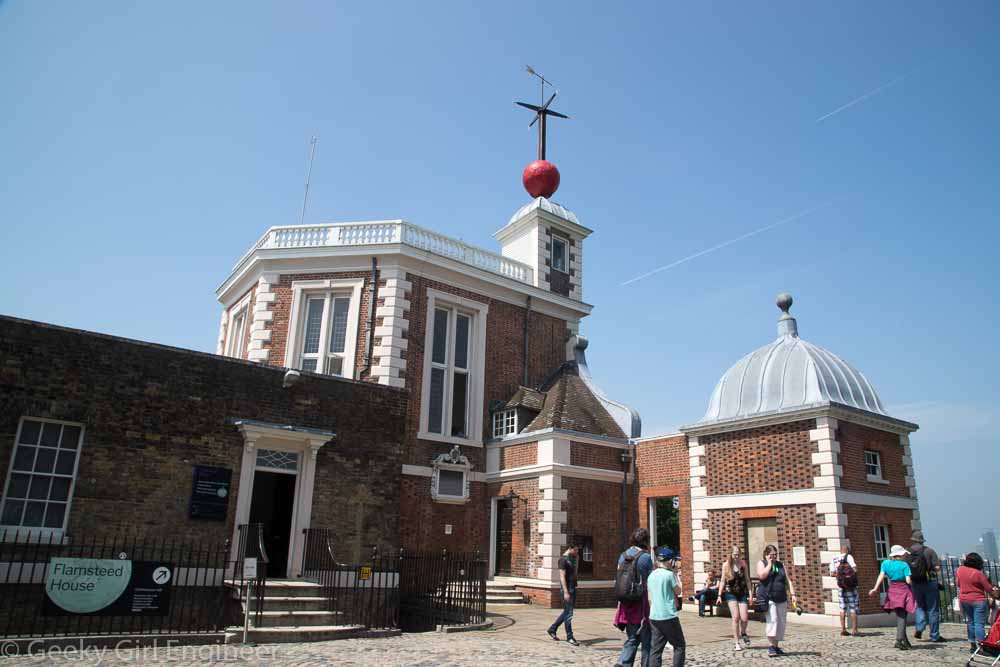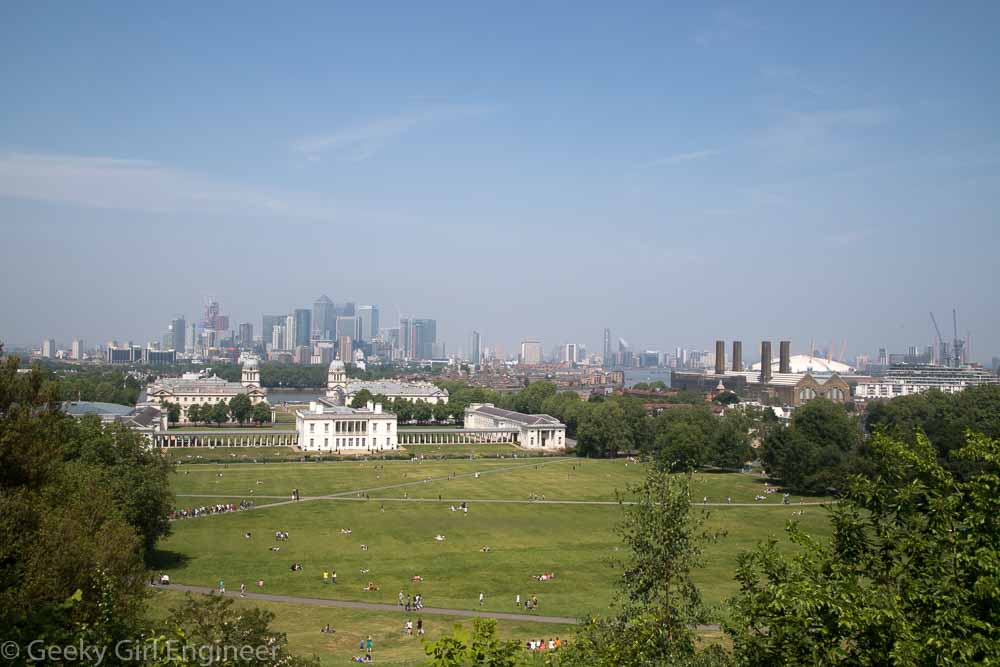When I travel to a new city, I like to just wander around taking photos. I am in Providence, so that is what I did. Providence is like a lot of old U.S. cities with old historic buildings mixed in with new buildings. I like old cities that preserve at least some of those old buildings. Providence has done that. It also has lots of river walk type areas, which makes for pleasant wandering.
Gettysburg Gun
Right past security at the entrance to the Rhode Island State Capitol, is the Gettysburg Gun. This cannon was used by Battery B of the 1st Rhode Island Light Artillery as they fought for the Union at Gettysburg in 1863. During the battle, members of the artillery was attempting to reload the cannon when it was struck by a Confederate shell. You can clearly see the dent on the left side of the bore. Two members of the artillery were killed, and other members attempted to keep reloading the gun, but the shell had compressed the mouth enough that the ball would not fully go in the gun. The men tried hammering the ball in, but the gun was hot from being fired numerous times and from being struck. Thus the gun was starting to cool after not being fired for several minutes, and the ball became permanently lodged in the mouth. It probably somewhat melted into place.
The gun became somewhat famous and a remembrance of the battle. It was put on display in Washington then in Rhode Island. It sat at the entrance to the Rhode Island Capitol for decades. Now here is the part I find most fascinating. It was not until 1962 that it dawned on people that the gun powder is loaded into a gun of this type BEFORE the ball is loaded. The ball got stuck while they were trying to load it. Hence in 1962 it finally occurred to some people that there was probably gun powder sitting in the barrel. Very old gun powder. Probably very unstable, old gun powder. Naval ordnance personnel and Rhode Island Army National Guard temporarily took the gun away. They put it into a pool and drilled two holes into it. You can see at least one of the holes on the front. It looks like two, but I am not positive if both are the drilled holes. Sure enough, there was gun powder in there. They flushed out two pounds of gun powder. They left the barrel flooded with water to disarm any residue gun powder before returning it to the capitol.
Our tour guide said the moral of the story is never stop asking questions. This gun was rendered safe because some nameless person asked questions and possibly prevented a horrible incident. I think one of the morals is assume all weapons are loaded. In my line of work as an environmental engineer, when I go to a site, I assume the site is contaminated until proven otherwise. When it comes to safety, plan for the worst, hope for the best. Even if that means a 100 year old weapon.
Rhode Island State Capitol
I visited the Rhode Island State Capitol today. One of my many travel goals is to visit all the state capitols. Like most states, Rhode Island has a lovely state capitol. I learned quite a bit on the tour I took. First trivia I learned is the official name of Rhode Island is actually the State of Rhode Island and Providence Plantations. Tiny state. Big name. Second thing I learned was that the present capitol was finished in 1904. There were several state houses before that, and for some time, the state legislature had no house and met sometimes in people’s houses. I can’t imagine having the entire house of representatives meet in an actual person’s house.
I digress. The capitol is beautiful and for the most part what you expect. It has the 5th largest marble dome in the world. [More trivia for you.] Lots of marble, brass, and painting. Not the fanciest one I have seen. It has lots of anchors to compete with Massachusetts’s fish everywhere. However, Rhode Island definitely wins bonus points for the motto in the women’s restroom. Photo below. I have no idea what is in the men’s restroom.
Finally see my next post. They have a cannon from Gettysburg at the entrance, and there is a really great story about it. So great, I am going to give it its own post.
MTA’s Jamaica Yards
I took another tour with the New York Transit Museum today. This one was of Jamaica Yards in Queens, where maintenance is performed on subway cars. I love touring these yards. Jamaica Yards was different then some of the other ones I have toured in that it has a bit more space. Not a lot, but at least a little more. Every time I go on one of these tours I learn and retain just a little more.
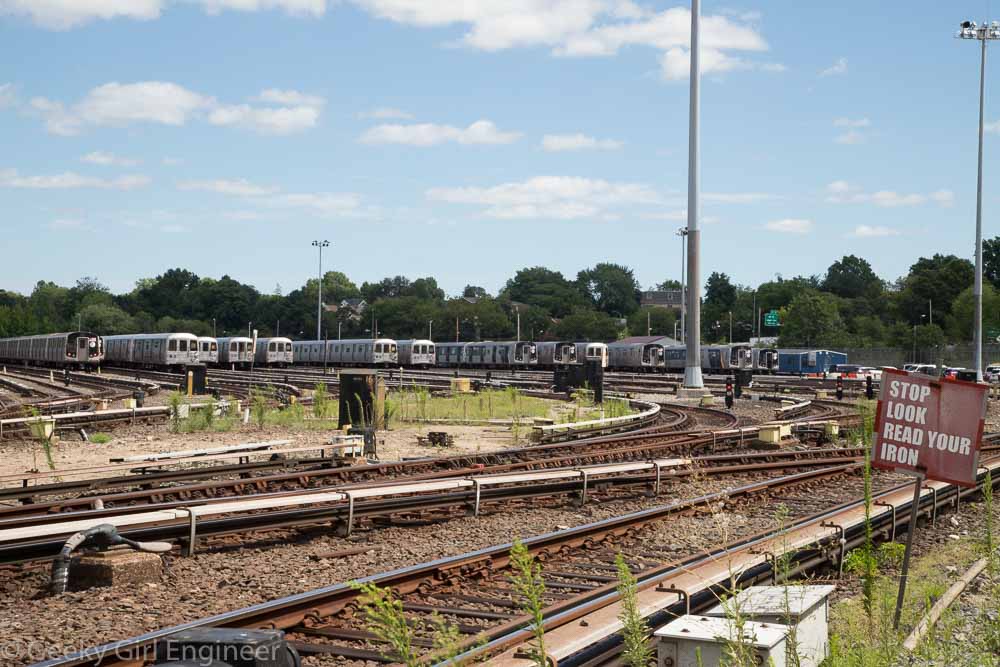
Jamaica Yards. “Stop look read your iron” is a warning to drivers to be alert where they are going. “Iron” refers to the rail.

Of course I am going to be interested int the safety measures. These lights read: Carbon monoxide alarm boiler room, methane alarm gas meter room, high water alarm car wash pump room, and car wash fire alarm.

One of the workers shows us how they test that the shoe, which contacts the third rail, is at the right height
Hudson River Valley by Train
I just got back from a very short trip to Albany, but the main reason I went to Albany was for the train ride up there. Amtrak has several train routes that go from New York City to Albany. I have taken two of these routes before, and I just love the view. I spend almost the entire time staring out the window at the gorgeous Hudson River, which can be seen during the vast majority of the ride. Below are a few photos I took on the route. The first six were taken on the train ride up to Albany as a storm was passing through and the sun was setting. The last three were taken on the way back down to New York City.
Albany, New York
I am visiting Albany for the day, and I spent the day wandering around downtown after I visited the state capitol. The area around the Capitol, Empire Plaza, was built during Governor Nelson Rockefeller’s term, and he evidently micromanaged the design. It is very modern architecture, and it is in complete contrast to the Capitol. The Empire Plaza is fun to photograph because of all the interesting lines of the buildings. The four identical Agency Towers provide repetitive vertical lines, but then The Egg is a weird curved structure. The Corning Tower in the Empire Plaza is the tallest building in the city and has an observation floor, which has outstanding views of the area. Away from the Empire Plaza, the rest of downtown Albany is a mix of historic buildings and some modern buildings. Also, Albany is right on the Hudson River, and a park on the river has nice views of the river.
New York State Capitol
I spent the day wandering around Albany today, and I started the day off with a tour of the Capitol. The New York Capitol is gorgeous. According to the tour guide, it was way over budget and way behind schedule when then Governor Teddy Roosevelt finally said, it’s done, no more. The guide pointed out some stone that was never carved because of that. The stone work is amazing none the less. There are numerous different stones used, and it is all exquisite.
From the outside, the building is beautiful, even without the domed tower it was supposed to have. I lost count of how many different architects the building had, but the style of the building is different in various areas because of that.
The Senate Chamber is gorgeous with gold paneling and beautiful marble tiles on the walls. My favorite part of it is that the chamber has two fireplaces that haven’t been used in decades since the building got central heat and air. Because of the acoustics in the chamber, it is hard to have a private conversation, so the two fireplaces are called “whispering fireplaces” where senators can have private conversation. They even keep folding chairs in the fireplaces for this activity. I find this hilarious. Even better, I noticed a fire extinguisher next to one of the fireplaces. Is it for heated political arguments?
The Assembly Chamber is not as exquisite as the Senate Chamber, but it is pretty also. According to the guide, the current ceiling in the room is the third one. The first one kept cracking and falling apart to the degree that large stones fell onto the ground. Then the second version was mainly papier-mache and wood. It was supposed to be solid wood, but such bad, vague specifications were written into the contract that the builder substituted papier-mache. At some point after this when the legislatures discovered this they sued, but they lost in court because the specifications were so bad. There is a lesson to be learned there. The paper-mache ended up saving the room during a fire in 1911. This is now the third ceiling, (I wasn’t clear on this) built after the fire.
The hallways and the staircases are some of the most beautiful areas of the building. The Great Western staircase is so beautiful that my photos cannot do it justice.
Jamestown Artifacts
My tour of Jamestown included a behind the scenes tour of the vault, where they keep many of the archeological finds and the laboratory where they process the finds. In the lab, our guide showed us how where they clean and dry the samples. She also explained how all the finds are identified and coded. My favorite part was her describing how they identify, collect, and store all artifacts found at the site, including potato chip bags, CDs, and USB drives. I suppose technically CDs are becoming historical objects.
The vault contains wonderful artifacts, and they are very clear to explain that the artifacts all represent historical trash. Essentially everything they have was found in a historical Jamestown trash hole. Many of the trash holes were water wells that became contaminated with salt water, so they just threw their trash in it for archeologists to dig up and treasure hundreds of years later. [Consider that next time you litter.] They have collected lots of bones from various wild and domesticated animals, pottery, glass, and metal objects. They have many old building material artifacts also. The collection is just amazing. What is even more amazing is what people throw away. Some things never change.
Historic Jamestown
I took a trip down to historic Jamestown for a tour that included not only the original fort, but also the “suburbs” of it, and a behind the scenes tour of the research area. [Photos from the research are on the next blog entry.] Jamestown is the site of the first permanent English settlement in North America. [Side note: I love all the modifiers. The lost colony of Roanoke NC disappeared and hence was not permanent. St. Augustine FL was Spanish. Let’s not even get started on all the Native American settlements.] The area is a continual archeological dig and is quite fascinating. The fort area is not that big really. Back then, it was big, I guess, and I am sure they men who built it in a very short period of time that it was huge and a huge amount of work. On the west side is the James River, and on the east side is wetlands. The area is beautiful, but back then without proper fresh water or AC, probably generally unpleasant.
In the original fort area, they have reproduced the fence surrounding it as well as a couple of buildings. They have also unearthed the footings of buildings. They have partially rebuilt the walls of the original church. The ruins of a later 17th century church tower remain as well as the sanctuary of a later church built on the grounds of several earlier churches. Archeologists are currently digging inside the newer church. They have placed crosses in the fort area where many of the bodies were found. There does not appear to be a cross for each person though. We saw a National Geographical movie on Jamestown on the way down, which helped me understand the history quite a bit. I can’t quite put into words what I felt visiting the area knowing the number of people who had died there, knowing the fighting with Native Americans that occurred as the English occupied their land, and knowing about the slaves that were later sold in the area. Somber, I guess. In one unearthed area in the original fort area, there is a brick structure visible in the cellar. It was in this area that they found the remains of a girl who had been cannibalized. It was survival cannibalism during the starving period, but still it is gruesome.
Outside the fort area are the brick footing remains of the later built House of Burgesses. On top of those footings is a museum. In another area, are the brick remains of residences and other buildings. The remains of a large residence are near the far end of the suburbs area, and this is where one of the first slaves to be sold on the continent came. Her name was Angela. There was other slaves sold alongside her, but hers is the only name known. They have started offering tours about slaves that were brought there besides just the tours of the fort area. I think it is a great idea as it gives a much better understanding of the full history of the area.

The front of the original church with partially reconstructed walls. The reconstructed structural posts of another building are in the background.

The brick in this dig area is from a cellar and where the remains of a cannibalized girl were found.
Royal Observatory
As I am an engineering geek, I felt that one of my must see stops on my London trip was to Greenwich to see the Royal Observatory. I think many people go just to take a photo of themselves on the Prime Meridian. That is a draw, even for me, and it clearly was popular based on how difficult it is to actually have a moment to take a photo on it without tens of other people in your photo frame. The observatory has some really good exhibits both about the history of the actual observatory and also timekeeping in general. It explains how it was first important for sailing and navigation. It is educational, and the displays of old timekeeping devices and navigation astronomy tools is fascinating. Also, the observatory is up on a hill and offers outstanding views of the area.


